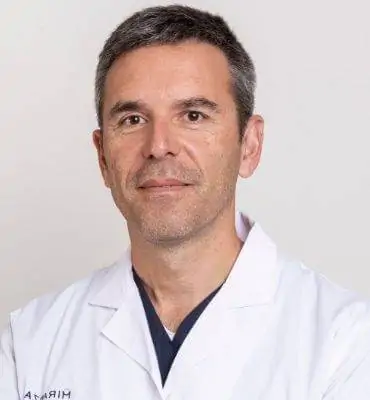What is eyelid microexfoliation?
Eyelid microexfoliation, also known as microblepharoexfoliation (BlephEx), consists of the complete and precise elimination of the crusting and remains of bacteria and oil that accumulate along the edges of the eyelids and cause inflammation and other eye discomfort (blepharitis). The aim is to reduce chronic symptoms, such as itching, tearing, stinging or foreign body sensation experienced by patients.
In which cases is it used?
The treatment is especially indicated for patients with blepharitis and/or Meibomian gland dysfunction, which is often associated with dry eye, as it reduces tear quality and can produce inflammation of the ocular surface.
BlephEx is a good reinforcement to eyelid hygiene, which patients with this chronic problem should perform carefully and regularly at home. It can also be carried out as a preventative measure in the same way that, for example, teeth cleaning is performed at the dentist’s once or twice a year.
Prior examination
Full optometric and ophthalmic examination, including additional tests that the specialist may require to confirm the diagnosis, such as meibography using an HD Analyzer to take an anatomical image of the Meibomian glands to determine whether they are atrophied and require treatment.
During treatment
The procedure takes less than 10 minutes and needs to be performed by a specialist in the consulting room because of the proximity and vulnerability of the eye. Although it is practically painless, it is carried out under topical anaesthesia (drops) for greater patient comfort.
BlephEx consists of a rotating hand piece featuring a disposable microsponge that moves along the edges of the eyelids to clean and exfoliate them in depth and with great precision. During treatment, patients usually only feel a slight tickling sensation in the eyelid area.
After treatment
Relief of symptoms is usually noticed almost immediately after the session. After treatment, it is important for the patient to follow a series of tips (new) to maintain good eyelid hygiene at home.
Depending on the habits and characteristics of each patient, the treatment is usually repeated every 3-6 months.
Associated pathologies
Experts performing this treatment
FAQs
In situations where dry eye symptoms occur, such as contact with chlorine in swimming pools, exposure to the sun or wind, air conditioning and eye strain (reading, driving, etc.), eye drop use should be increased. If symptoms persist, however, patients should see an ophthalmologist to assess the possibility of using other treatments.
It is the result of tear secretion and eyelid disorders that can cause redness, itching, burning, the sensation of a foreign body in the eye and eyestrain. Proper lubrication of the eye is achieved with a correct balance of good-quality tear production and the normal functioning of the eyelids. When this balance is broken or altered by external factors, tear production decreases, and there is a propensity for dry eye to develop.
Normal cellular aging in humans leads to reduced tear production. In fact, it is estimated that between the ages of 10 and 40, tear production is reduced by 50%. In addition, other common causes of dry eye are eye infections (conjunctivitis, corneal ulcers, etc.), external or environmental factors (sun, wind, chlorine, contact lenses, etc.) and certain medication. Cosmetics and cleansing creams can also cause irritation and disrupt tear production.
IMO Institute of Ocular Microsurgery
Josep María Lladó, 3
08035 Barcelona
Phone: (+34) 934 000 700
E-mail: international@imo.es
See map on Google Maps
By car
GPS navigator coordinates:
41º 24’ 38” N – 02º 07’ 29” E
Exit 7 of the Ronda de Dalt (mountain side). The clinic has a car park with more than 200 parking spaces.
By bus
Autobus H2: Rotonda de Bellesguard, parada 1540
Autobus 196: Josep Maria Lladó-Bellesguard, parada 3191
Autobuses H2, 123, 196: Ronda de Dalt – Bellesguard, parada 0071
How to arrive at IMO from:
IMO Madrid
C/ Valle de Pinares Llanos, 3
28035 Madrid
Phone: (+34) 910 783 783
See map in Google Maps
Public transport
Metro Lacoma (líne 7)
Autobuses:
- Lines 49 & 64, stop “Senda del Infante”
- Line N21, stop “Metro Lacoma”
Timetables
Patient care:
Monday to Friday, 8 a.m. to 8 p.m.
IMO Andorra
Av. de les Nacions Unides, 17
AD700 Escaldes-Engordany, Andorra
Phone: (+376) 688 55 44
See map in Google Maps
IMO Manresa
C/ Carrasco i Formiguera, 33 (Baixos)
08242 – Manresa
Tel: (+34) 938 749 160
See map in Google Maps
Public transport
FGC. Line R5 & R50 direction Manresa. Station/Stop: Baixador de Manresa
Timetables
Monday to Friday, 08:30 A.M – 13:30 PM / 15:00 PM – 20:00 PM










